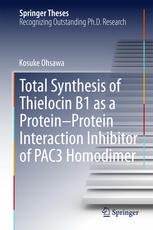

Most ebook files are in PDF format, so you can easily read them using various software such as Foxit Reader or directly on the Google Chrome browser.
Some ebook files are released by publishers in other formats such as .awz, .mobi, .epub, .fb2, etc. You may need to install specific software to read these formats on mobile/PC, such as Calibre.
Please read the tutorial at this link: https://ebookbell.com/faq
We offer FREE conversion to the popular formats you request; however, this may take some time. Therefore, right after payment, please email us, and we will try to provide the service as quickly as possible.
For some exceptional file formats or broken links (if any), please refrain from opening any disputes. Instead, email us first, and we will try to assist within a maximum of 6 hours.
EbookBell Team

5.0
40 reviewsThis book focuses on thielocin B1 (TB1), which was found to be an inhibitor of protein–protein interactions (PPIs) of proteasome assembling chaperone (PAC) 3 homodimer, and elucidates the mechanism by nuclear magnetic resonance (NMR) studies. Interfaces of PPIs recently have been expected to be novel therapeutic targets, while it is difficult to apply conventional methodology based on lock and key theory. The author achieved the first total synthesis of TB1 and its spin-labeled derivative to carry out NMR experiments because the supply of TB1 from natural sources was limited. Unique 2,2’,6,6’-tetrasubstituted diphenyl ether moiety of TB1 was synthesized from a depsidone skeleton by chemoselective reduction of lactone. In the process of elongating side wings, efficient formylation utilizing dichloromethyl methyl ether–silver trifluoromethanesulfonate was developed for the sterically hindered aromatic compound. NMR titration experiments and paramagnetic relaxation enhancement observation of PAC3 homodimer were performed with synthesized TB1 and its molecular probe, respectively. The results of the above NMR studies and additional in silico docking studies suggested that TB1 promotes the dissociation to monomeric PAC3 after interaction with PAC3 homodimer. The rare mechanism shown in this book indicates a potential novel drug target in the interfaces of PPIs with no cavity or groove.